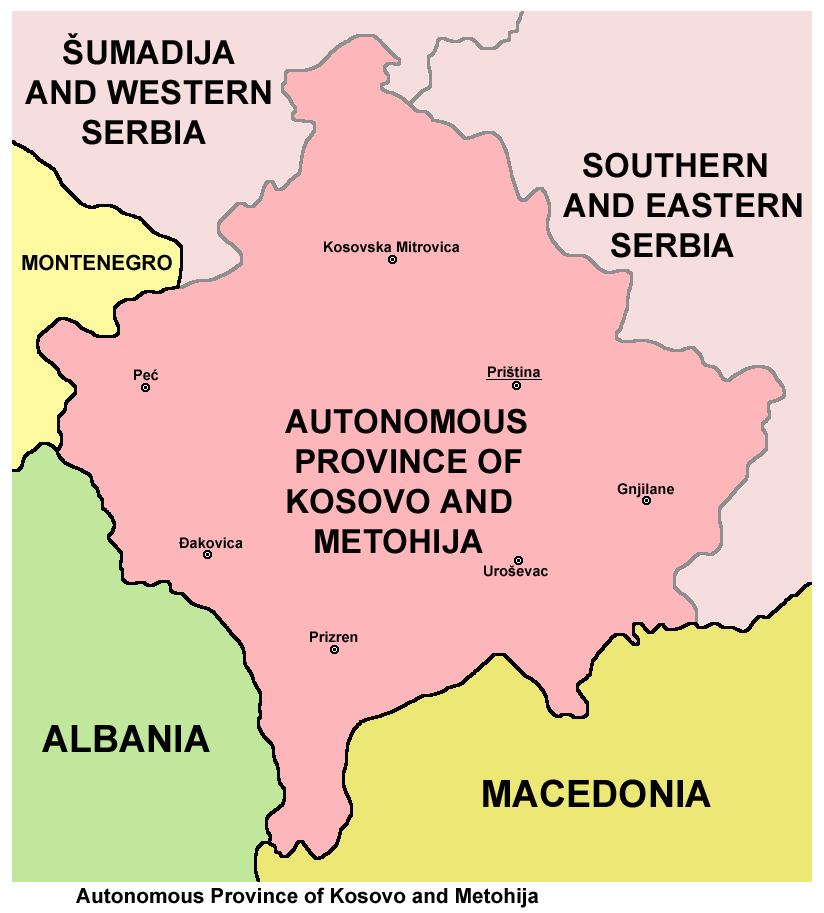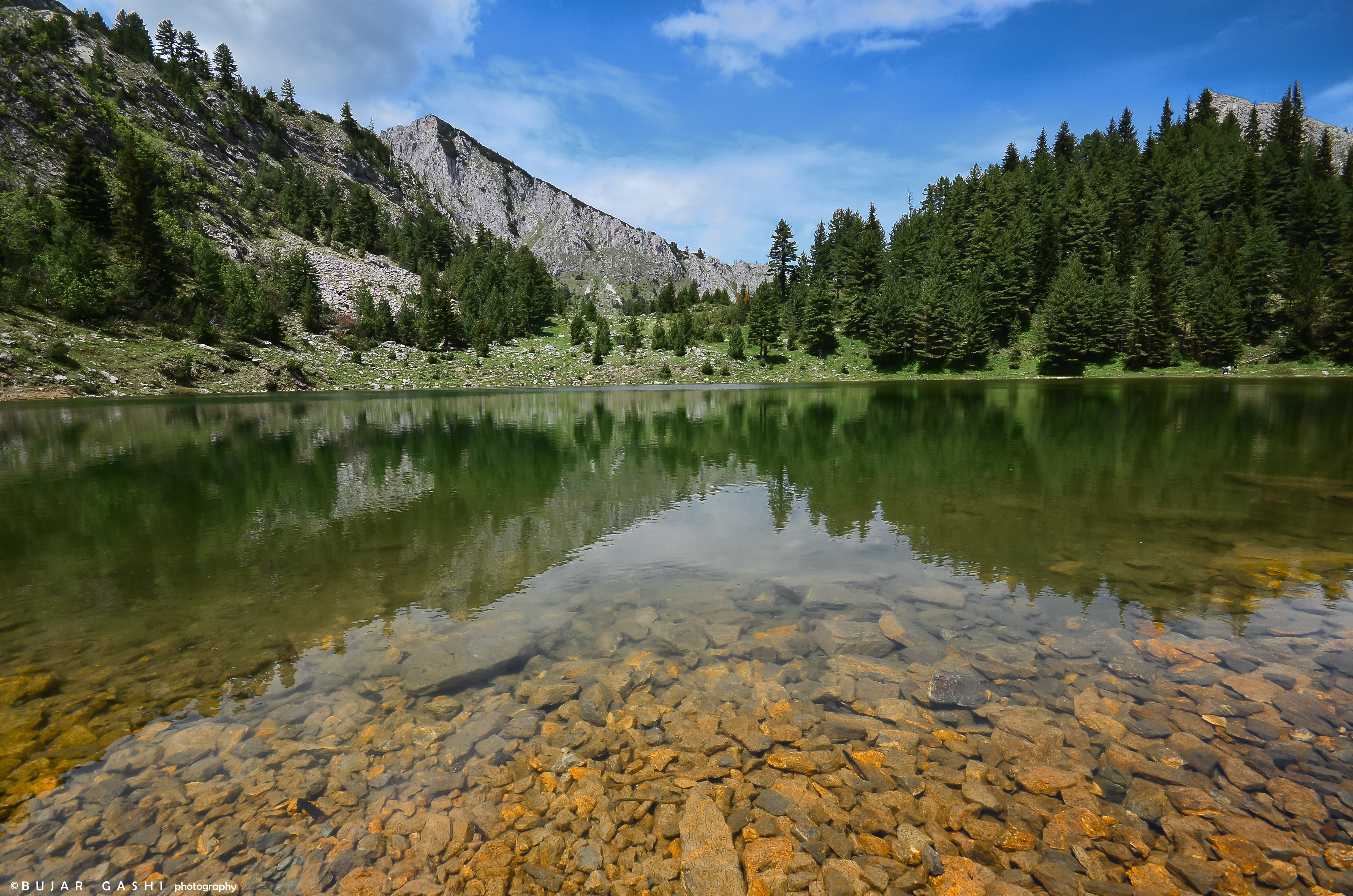|
Kosovo–Metohija
The Autonomous Province of Kosovo and Metohija (APKM) (; ), commonly known as Kosovo (; ) and abbreviated to Kosmet (from '' Kosovo'' and '' Metohija''; ) or KiM (), is an autonomous province that occupies the southernmost corner of Serbia, as defined by the country's constitution. The territory is the subject of an ongoing political and territorial dispute between the Republic of Serbia and the partially recognised Republic of Kosovo, with the APKM being viewed as the ''de jure'' interpretation of the territory under Serbian law; however, the Serbian government currently does not control the territories because they are administered by the Republic of Kosovo. Its claimed administrative capital and largest city is Pristina. The territory of the province, as defined by Serbian laws, lies in the southern part of Serbia and covers the regions of Kosovo and Metohija. The capital of the province is Pristina. The territory was previously an autonomous province of Serbia during So ... [...More Info...] [...Related Items...] OR: [Wikipedia] [Google] [Baidu] |
Socialist Autonomous Province Of Kosovo
The Socialist Autonomous Province of Kosovo, sh-Latn-Cyrl, Socijalistička Autonomna Pokrajina Kosovo, Социјалистичка Аутономна Покрајина Косово, separator=" / "; ; . Also abbreviated as SAP Kosovo. referred to simply as Kosovo, was one of the two autonomous provinces of the Socialist Republic of Serbia within Yugoslavia (the other being Vojvodina), between 1945 and 1990, when it was renamed Autonomous Province of Kosovo and Metohija. Between 1945 and 1963 it was officially named the Autonomous Region of Kosovo and Metohija, with a level of self-government lower than that of the Autonomous Province of Vojvodina. In 1963 it was granted the same level of autonomy as Vojvodina, and accordingly its official name was changed to Autonomous Province of Kosovo and Metohija. In 1968 the term "Metohija" was dropped, and the prefix "Socialist" was added, changing the official name of the province to Socialist Autonomous Province of Kosovo. In 1974 bo ... [...More Info...] [...Related Items...] OR: [Wikipedia] [Google] [Baidu] |
Administrative Divisions Of Serbia
The administrative divisions of Serbia are regulated by the Government decree of 29 January 1992, and by the Law on Territorial Organization adopted by the National Assembly on 29 December 2007.Government of SerbiaDistricts In Serbia/ref>Law on Territorial Organization and Local Self-Government Parliament of Serbia There are two types of administrative divisions in : political (regional and local self-government - ''autonomous provinces'' and ''cities and municipalities'') and administrative (''administrative districts'' for decentralized services of the state and ''statistical regions'' for statistical purposes). Political divisions < ...
|
Serbian Language
Serbian (, ) is the standard language, standardized Variety (linguistics)#Standard varieties, variety of the Serbo-Croatian language mainly used by Serbs. It is the official and national language of Serbia, one of the three official languages of Bosnia and Herzegovina and co-official in Montenegro and Kosovo. It is a recognized minority language in Croatia, North Macedonia, Romania, Hungary, Slovakia, and the Czech Republic. Standard Serbian is based on the most widespread dialect of Serbo-Croatian, Shtokavian (more specifically on the dialects of Šumadija–Vojvodina dialect, Šumadija-Vojvodina and Eastern Herzegovinian dialect, Eastern Herzegovina), which is also the basis of Croatian language, standard Croatian, Bosnian language, Bosnian, and Montenegrin language, Montenegrin varieties and therefore the Declaration on the Common Language of Croats, Bosniaks, Serbs, and Montenegrins was issued in 2017. The other dialect spoken by Serbs is Torlakian dialect, Torlakian in south ... [...More Info...] [...Related Items...] OR: [Wikipedia] [Google] [Baidu] |
United Nations Administered Kosovo
United Nations Administered Kosovo refers to the period between 1999 and 2008 when the United Nations Interim Administration Mission in Kosovo was directly responsible for the governance of Kosovo. This period began on 10 June 1999 with the passing of United Nations Security Council Resolution 1244 and effectively ended on 17 February 2008 with the 2008 Kosovo declaration of independence, unilateral declaration of independence of Kosovo. Background In 1945, at the conclusion of the Second World War, Kosovo was organised within the Socialist Federal Republic of Yugoslavia (SFRY) as the Autonomous Region of Kosovo and Metohija. In 1963 the region was reorganised as the Autonomous Province of Kosovo and Metohija with increased autonomy and was renamed as the Socialist Autonomous Province of Kosovo in 1968. In 1975 Kosovo was granted significantly increased levels of autonomy. In 1990, under the regime of Slobodan Milošević, the level of autonomy was reduced and the official name ... [...More Info...] [...Related Items...] OR: [Wikipedia] [Google] [Baidu] |
Socialist Federal Republic Of Yugoslavia
The Socialist Federal Republic of Yugoslavia (commonly abbreviated as SFRY or SFR Yugoslavia), known from 1945 to 1963 as the Federal People's Republic of Yugoslavia, commonly referred to as Socialist Yugoslavia or simply Yugoslavia, was a country in Central Europe, Central and Southeast Europe. It was established in 1945, following World War II, and lasted until 1992, breakup of Yugoslavia, dissolving amid the onset of the Yugoslav Wars. Spanning an area of in the Balkans, Yugoslavia was bordered by the Adriatic Sea and Italy to the west, Austria and Hungarian People's Republic, Hungary to the north, People's Republic of Bulgaria, Bulgaria and Socialist Republic of Romania, Romania to the east, and People's Socialist Republic of Albania, Albania and Greece to the south. It was a One-party state, one-party socialist state and federation governed by the League of Communists of Yugoslavia, and had six constituent republics: Socialist Republic of Bosnia and Herzegovina, Bosnia and Her ... [...More Info...] [...Related Items...] OR: [Wikipedia] [Google] [Baidu] |
Socialist Republic Of Serbia
The Socialist Republic of Serbia ( sh-Cyrl-Latn, separator=" / ", Социјалистичка Република Србија, Socijalistička Republika Srbija), previously known as the People's Republic of Serbia ( sh-Cyrl-Latn, separator=" / ", Народна Република Србија, Narodna Republika Srbija, National Republic of Serbia), commonly abbreviated as Republic of Serbia, SR Serbia or simply Serbia, was one of the six Constituent republics of the Socialist Federal Republic of Yugoslavia, constituent republics of the Socialist Federal Republic of Yugoslavia in what is now the modern day states of Serbia and the disputed territory of Kosovo. Its formation was initiated in 1941, and achieved in 1944–1946, when it was established as a federated republic within Yugoslavia. In that form, it lasted until the constitutional reforms from 1990 to 1992, when it was reconstituted, as the Republic of Serbia (1992–2006), Republic of Serbia within the Federal Republic of ... [...More Info...] [...Related Items...] OR: [Wikipedia] [Google] [Baidu] |
Geography Of Kosovo
Kosovo is a landlocked country in Southeastern Europe. The country is strategically positioned in the center of the Balkan Peninsula enclosed by Montenegro to the west, Serbia to the north and east, North Macedonia to the southeast, and Albania to the southwest. It has no direct access to the Mediterranean Sea but its rivers flow into three seas, the Adriatic, Aegean and Black Sea. The country possesses impressive and contrasting landscapes determined by the climate along with the geology and hydrology. Both, the Bjeshkët e Nemuna and Sharr Mountains, are the most defining feature of the country and simultaneously the most biodiverse regions of Kosovo. As far as the central region, the plains of Dukagjin and Kosovo stretches over the west and east, respectively. Additionally, Kosovo consists of multiple geographic and ethnographic regions, such as Drenica, Dushkaja, Gollak, Has, Highlands of Gjakova, Llap, Llapusha and Rugova. The country is a quite rich country for its ... [...More Info...] [...Related Items...] OR: [Wikipedia] [Google] [Baidu] |
Kosovo
Kosovo, officially the Republic of Kosovo, is a landlocked country in Southeast Europe with International recognition of Kosovo, partial diplomatic recognition. It is bordered by Albania to the southwest, Montenegro to the west, Serbia to the north and east, and North Macedonia to the southeast. It covers an area of and has a population of approximately 1.6 million. Kosovo has a varied terrain, with high plains along with rolling hills and List of mountains in Kosovo, mountains, some of which have an altitude over . Its climate is mainly Continental climate, continental with some Mediterranean climate, Mediterranean and Alpine climate, alpine influences. Kosovo's capital and List of cities and towns in Kosovo#List, most populous city is Pristina; other major cities and urban areas include Prizren, Ferizaj, Gjilan and Peja. Kosovo formed the core territory of the Dardani, an ancient Paleo-Balkanic languages, Paleo-Balkanic people attested in classical sources from the 4th cent ... [...More Info...] [...Related Items...] OR: [Wikipedia] [Google] [Baidu] |
Political Status Of Kosovo
The political status of Kosovo, also known as the Kosovo question, is the subject of a long-running political and territorial dispute between the Serbian (and previously, Yugoslav) government and the Government of Kosovo, stemming from the breakup of Yugoslavia (1991–92) and the ensuing Kosovo War (1998–99). In 1999, the administration of the Autonomous Province of Kosovo and Metohija was handed on an interim basis to the United Nations under the terms of UNSCR 1244 which ended the Kosovo conflict of that year. That resolution reaffirmed the territorial integrity of Serbia over Kosovo but required the UN administration to promote the establishment of 'substantial autonomy and self-government' for Kosovo pending a 'final settlement' for negotiation between the parties. The UN-sponsored talks began in February 2006, and though no agreement was reached between the parties, a proposal from UN Special Envoy Martti Ahtisaari was presented in May 2007 which recommended 'supervise ... [...More Info...] [...Related Items...] OR: [Wikipedia] [Google] [Baidu] |
Constitution Of Serbia
The current Constitution of the Republic of Serbia (), also known as Mitrovdan Constitution () is the supreme and basic law of Serbia. It was adopted in 2006, replacing the previous constitution dating from 1990. History The adoption of current constitution became necessary in 2006 when Serbia restored its independence following Montenegro's secession and the subsequent dissolution of Serbia and Montenegro. The proposed text of the constitution was adopted by the National Assembly on 30 September 2006 and put on constitutional referendum which was held on 28–29 October 2006. After 53% of the electorate voted in favor of the proposed constitution, it was officially adopted on 8 November 2006. A constitutional referendum was held again on 16 January 2022, in which voters decided on changing the constitution in the provisions related to the judiciary. To bring the judiciary into line with European Union legislation, the Government of Serbia had previously proposed changing the ... [...More Info...] [...Related Items...] OR: [Wikipedia] [Google] [Baidu] |
Autonomous Province
Autonomous province is a term for a type of province that has administrative autonomy. accessed 4 Feb 2020 In political history, the term has been used as a designation for various types of autonomous entities, at medium levels of administrative hierarchy. In relative terms, an autonomous province usually has less autonomy than an '' autonomous state'', but more autonomy than an ''''. Administrative autonomy of a province can be expressed in its official name, by the use of a particular term designating the autonomy, but such a term can also be omitted. In that case ... [...More Info...] [...Related Items...] OR: [Wikipedia] [Google] [Baidu] |
Metohija
Metohija (), also known in Albanian as Dukagjini, (, ) is a large drainage basin, basin and the name of the region covering the southwestern part of Kosovo. The region covers 35% (3,891 km2) of Kosovo's total area. According to the 2024 census, the population of the region is 570,147. Names The name ''Metohija'' derives from the Greek language, Greek word (''metóchia''; singular , ''metochion, metóchion''), meaning "monastic estates" – a reference to the large number of villages and estates in the region that were owned by the Serbian Orthodox Church, Serbian Orthodox monasteries and Mount Athos during the Serbia in the Middle Ages, Middle Ages. In Albanian language, Albanian the area is called ''Rrafshi i Dukagjinit'' and means "the plateau of Dukagjin", as the toponym (in Albanian) took the name of the Dukagjini family who ruled a large part of Dukagjini during the 14th-15th centuries. According to Jahja Drançolli, a professor at the University of Pristina, ... [...More Info...] [...Related Items...] OR: [Wikipedia] [Google] [Baidu] |







